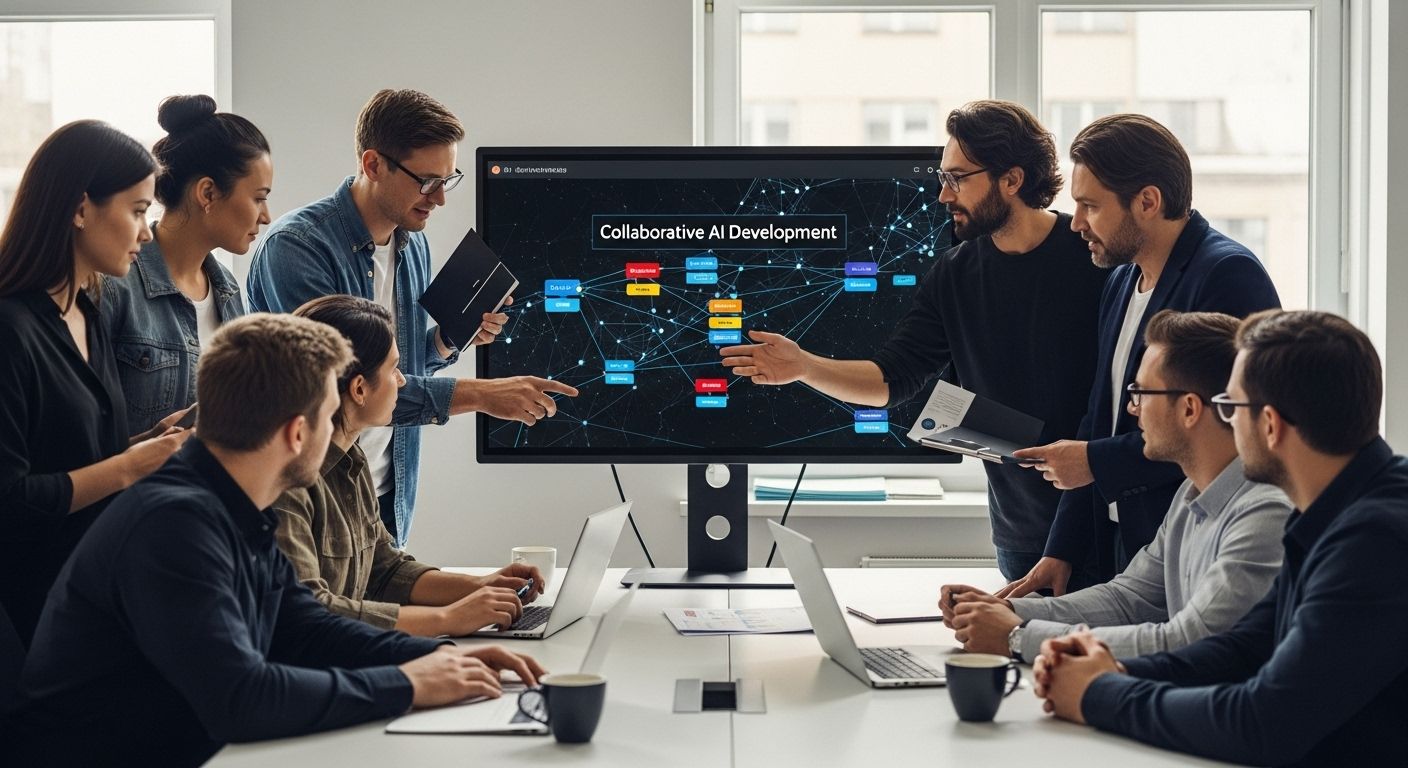
Understanding Collaborative AI Development and Its Impact
Collaborative AI development is changing the way humans and intelligent machines build solutions together. These systems can speed up innovation by combining the power of multiple AI agents and human expertise, making it possible to solve problems that individual AIs could never tackle alone. Most people think of AI as a solo act or a stand-alone tool. The surprise is that true breakthroughs happen when these agents work as a team. That shift turns traditional development on its head and opens new doors that single AI models simply cannot reach.
Table of Contents
- What Is Collaborative AI Development?
- Why Is Collaborative AI Development Important?
- How Collaborative AI Development Works
- Key Concepts In Collaborative AI Development
Quick Summary
| Takeaway | Explanation |
|---|---|
| Collaborative AI promotes teamwork among AIs and humans | This approach enables AI agents and developers to interact and work together on complex problems dynamically. |
| Adaptive learning enhances problem-solving capabilities | Systems adjust their strategies based on collective input, improving their effectiveness in tackling challenges. |
| Interconnected networks outperform isolated AI systems | Collaborative frameworks allow for shared knowledge and resources, significantly boosting innovation and solutions. |
| Robust communication structures are essential | Clear protocols for interaction allow AI agents to share insights and negotiate effectively, enabling seamless collaboration. |
| Addressing global issues requires a collaborative effort | Integrated collaborative AI can address critical challenges like healthcare and climate change more effectively than traditional models. |
What is Collaborative AI Development?
Collaborative AI development represents a groundbreaking approach to creating intelligent systems where multiple AI agents, human developers, and computational resources work together synergistically to solve complex problems. Advancing intelligent systems requires more than traditional linear development models.
Core Principles of Collaborative AI
At its fundamental level, collaborative AI development involves creating intelligent systems that can interact, learn, and make decisions through interconnected networks of computational agents and human expertise. Key characteristics include:
- Distributed Intelligence: Multiple AI agents share knowledge and computational resources
- Adaptive Learning: Systems can dynamically adjust strategies based on collaborative inputs
- Transparent Interaction: Clear communication protocols between AI agents and human developers
To clarify and compare the core principles of collaborative AI, the following table summarizes each principle and its explanation as described in the article.
| Core Principle | Explanation |
|---|---|
| Distributed Intelligence | Multiple AI agents share knowledge and computational resources |
| Adaptive Learning | Systems dynamically adjust strategies based on collaborative inputs |
| Transparent Interaction | Clear communication protocols between AI agents and human developers |
Mechanisms of Collaboration
The collaborative approach goes beyond simple task delegation. It involves intricate frameworks where AI systems can negotiate, exchange information, and collectively solve problems that would be challenging for individual agents. These mechanisms often leverage advanced machine learning techniques like federated learning, multi-agent reinforcement learning, and knowledge transfer protocols.
For software engineers interested in practical applications, AI pair programming techniques offer an excellent example of collaborative AI in action. By integrating intelligent systems directly into the development workflow, engineers can enhance productivity and problem-solving capabilities.
Ultimately, collaborative AI development represents a paradigm shift from isolated, monolithic AI systems to interconnected, adaptive networks that can dynamically respond to complex challenges across scientific, technological, and societal domains.
Why is Collaborative AI Development Important?
Collaborative AI development has become increasingly critical in addressing complex technological and societal challenges that surpass the capabilities of traditional, siloed development approaches. Research from the National Science Foundation underscores the transformative potential of collaborative frameworks in accelerating scientific and technological innovation.
Advancing Technological Capabilities
The importance of collaborative AI development stems from its ability to pool diverse expertise, computational resources, and knowledge across multiple domains. Key advantages include:
- Increased Problem-Solving Complexity: Ability to tackle more sophisticated challenges
- Rapid Innovation: Accelerated development through shared knowledge and resources
- Cross-Disciplinary Integration: Breaking down barriers between different technological and scientific domains
Addressing Global Challenges
Collaborative AI development enables more comprehensive approaches to solving critical global issues. By creating interconnected systems that can share intelligence and adapt dynamically, researchers and developers can develop more robust solutions to problems in healthcare, climate change, scientific research, and technological innovation.
For software engineers looking to understand practical implementation, exploring advanced AI collaboration techniques provides insights into how intelligent systems can work together effectively.
Moreover, collaborative AI development represents a strategic approach to mitigating individual system limitations. By creating networks of intelligent agents that can communicate, learn, and adapt collectively, we move beyond the constraints of individual AI models towards more powerful, flexible, and intelligent technological ecosystems.
How Collaborative AI Development Works
Collaborative AI development operates through sophisticated mechanisms that enable multiple intelligent systems to interact, learn, and solve complex problems collectively. According to research from the National Science Foundation, these frameworks require intricate coordination and advanced communication protocols.
Communication and Knowledge Sharing Frameworks
At the core of collaborative AI development are advanced communication architectures that allow different AI agents to exchange information, share learning experiences, and collectively refine their problem-solving strategies. Key components of these frameworks include:
- Distributed Learning Algorithms: Enable AI agents to share computational insights
- Federated Machine Learning: Allows training across decentralized devices without raw data exchange
- Dynamic Resource Allocation: Intelligent systems dynamically assign computational tasks
Technical Implementation Mechanisms
Collaborative AI development utilizes multiple technical approaches to create interconnected intelligent systems. These include multi-agent reinforcement learning, where different AI agents learn and adapt through interactions, and knowledge transfer protocols that enable seamless information sharing across different computational environments.
For software engineers seeking practical insights, understanding advanced AI collaboration techniques provides a concrete perspective on implementation strategies.
The process involves creating intelligent systems with built-in capabilities for negotiation, consensus building, and adaptive learning. By designing AI agents that can communicate, interpret each other’s outputs, and collectively refine their strategies, collaborative AI development transcends traditional linear computational models, creating more robust and flexible intelligent networks.
Key Concepts in Collaborative AI Development
Research from MIT Media Lab highlights the transformative potential of collaborative AI development, emphasizing that understanding its core principles is crucial for leveraging intelligent systems effectively.
Fundamental Architectural Principles
Collaborative AI development is built upon several foundational concepts that enable intelligent systems to work together seamlessly. These principles create the infrastructure for advanced computational cooperation:
- Agent Interoperability: Ensuring different AI systems can communicate and understand each other
- Adaptive Learning Protocols: Mechanisms that allow AI agents to learn from collective experiences
- Consensus Mechanisms: Strategies for resolving computational disagreements and validating shared insights
Technical Interaction Frameworks
The technical backbone of collaborative AI development involves sophisticated interaction models that go beyond simple data exchange. These frameworks enable intelligent agents to negotiate, interpret, and collectively solve complex problems through advanced communication strategies.
For software engineers seeking practical implementation strategies, exploring practical AI collaboration techniques provides crucial insights into real-world application.
Moreover, collaborative AI development requires robust governance models that address critical challenges such as ethical considerations, bias mitigation, and transparent decision-making processes. By establishing clear protocols for interaction, validation, and collective problem-solving, these systems transform traditional computational approaches into dynamic, intelligent networks capable of addressing increasingly complex technological challenges.
Unlock Real Collaborative AI Skills With Expert Guidance
Want to learn exactly how to build collaborative AI systems that actually work in production? Join the AI Engineering community where I share detailed tutorials, code examples, and work directly with engineers building multi-agent AI systems and distributed intelligence frameworks.
Inside the community, you’ll find practical, results-driven collaborative AI strategies that actually work for growing companies, plus direct access to ask questions and get feedback on your implementations.
Frequently Asked Questions
What is Collaborative AI Development?
Collaborative AI development is an approach where multiple AI agents and human developers work together to create intelligent systems that can solve complex problems through shared knowledge and resources.
Why is Collaborative AI Development important?
It allows for tackling sophisticated challenges, accelerates innovation by pooling expertise and resources, and promotes cross-disciplinary integration to address global issues effectively.
How does Collaborative AI Development work?
It operates through advanced communication frameworks and mechanisms such as distributed learning algorithms, federated machine learning, and dynamic resource allocation, enabling AI systems to learn and adapt collectively.
What are the key concepts in Collaborative AI Development?
Key concepts include agent interoperability, adaptive learning protocols, and consensus mechanisms that facilitate effective communication and problem-solving among interconnected AI systems.
Recommended
- How to Use AI for Pair Programming Effectively?
- How Does AI Pair Programming Work and Should I Use It?
- Why Does AI Generate Outdated Code and How Do I Fix It?
- Why Does AI Give Outdated Code and How to Fix It?
